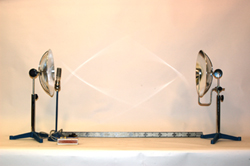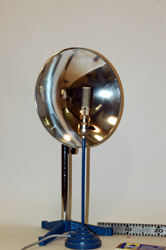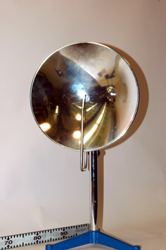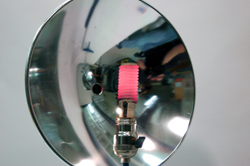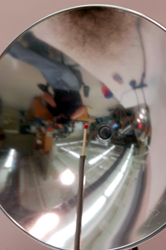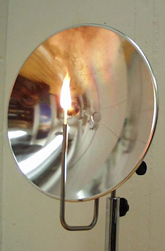|
Size: 1598
Comment:
|
← Revision 29 as of 2018-07-18 19:13:18 ⇥
Size: 5225
Comment:
|
| Deletions are marked like this. | Additions are marked like this. |
| Line 3: | Line 3: |
| '''pira200 Listed''' | |
| Line 5: | Line 6: |
| * '''Cabinet:''' Thermodynamics Cabinet * '''Bay:''' (B3) |
* '''Cabinet:''' Thermodynamics Cabinet * '''Bay:''' [[ThermoCabinetBayB3|(B3)]] |
| Line 9: | Line 11: |
| attachment:TD4B40_10-01a.jpg | {{attachment:TD4B40_10-01a.jpg}} |
| Line 13: | Line 15: |
| Insert description of apparatus, its component, what it is demonstrating. | Radiative Heat Transfer, locally known as Light the Match. |
| Line 15: | Line 17: |
| ||<:style="width: 60%" :40%>'''Equipment'''||<:30%>'''Location'''||<:25%>'''ID Number'''|| | Two large parabolic reflectors, 12 inches in diameter, one with a "white tipped" stick match at it's focus and the other with a nichrome heater element at it's focus. Each reflector has two adjusters on it, one adjusts for height and the other for tilt angle. Both adjusters will be important when it come to aligning the foci of both reflectors. ||<40% style="" ;text-align:center">'''Equipment''' ||<30% style="text-align:center">'''Location''' ||<25% style="text-align:center">'''ID Number''' || |
| Line 17: | Line 20: |
| ||Two Parabolic reflectors||[:ThermoCabinetBayB3: TD, B3, Shelf #1]||<:>4B40.10 || ||Heater||[:ThermoCabinetBayB3: TD, B3, Shelf #1]|| || ||Match|| || || |
||Two Parabolic reflectors With Heater ||[[ThermoCabinetBayB3|TD, B3, Shelf #1]] ||<style="text-align:center">4B40.10 || ||Spare Heaters ||[[ThermoCabinetBayA1|TD, A1, Shelf #2]] || || ||Match ||[[ThermoCabinetBayA1|TD, A1, Shelf #1]] || || |
| Line 22: | Line 25: |
| '''Setup:''' | |
| Line 24: | Line 26: |
| 1. Aligned the two parabolic reflectors across the table. 1. Put the heater at the focus of one reflector and a match at the focus of the others. |
'''Setup:''' Alignment of the two parabolic reflectors: Alignment can be tricky and time consuming the further apart you place the two reflectors. 3 meters seems to be the maximum separation with this system. 1. The set up process might take time, so it would be a good idea to set up the demo beforehand. 1. Place the parabolic reflector with the heater at one end of the table. 1. Move the heater in and out of the focus to find the foci. The best way to do this is to put your face in the line of sight of the reflector. When the whole reflector has a red-orange glow and you can feel the heat on your face, you're good to go. The heater is close to the focus point of the reflector. Make sure that the whole reflector has this red-orange glow to it all the way the the receiving reflector. One may have to adjust the reflector’s tilt angle or height to maximize the reflectivity of the heat. 1. Across the table move the receiving reflector in the line of sight of the transmitted radiation. Again one may have to adjust the reflector’s tilt angle or height to maximize the heat being received. 1. To find the focus of the match tip to go into. One can use a peace of paper or there finger tip to feel and see the re-focused heat spot. Caution! When using your finger to find the best location for the match, this hot spot is “HOT” and can be painful and burn. 1. Once the spot has been found, wiggle the match tip into place. One may have to adjust the match’s height and/or distances from the reflector to reach the maximize amount reflectivity of the heat to ignite the match. |
| Line 28: | Line 39: |
| Line 29: | Line 41: |
| 2. Beware of the heater. | 1. Beware of the heater. 1. When using your finger to find the best location for the match, this hot spot is “HOT” and can be painful and even burn. |
| Line 31: | Line 44: |
| '''Demonstration:''' | '''Demonstration:''' |
| Line 33: | Line 46: |
| This demonstration shows that the energy of infrared radiation can be focused and transmitted much the same way as light. After set up, you just plug the heater in to the outlet and wait. You will see that the match is light due to the heat radiation focuses and transmits to the match. | This demonstration shows radiative heat transfer, heat energy or infrared radiation, which can be focused and then transmitted much the same way as light and sound waves can. After setup, you just need to plug the heater into an outlet and wait. Now you can try placing the piece of paper or metal in to the path of the radiation so that the students can see how the light is being reflected off of the first mirror. It helps them to see that infrared waved, or heat, acts just like visible light, even though they cannot see it. Another thing to show students in this demo is that although they may not be able see the infrared radiation, they can certainly feel it. Ask for a volunteer to hold up their hand in the direct path of the light reflecting off the first mirror. Don't worry, the students won't burn themselves, but they will be able to feel the increase in temperature caused by the light waves. After you put the match on the focal point of the receiving reflector, and then just wait. The wait time depends on how close the reflectors are to each other. The further apart the reflectors the longer the time will be. The match will flare up and catch on fire due to the radiative heat being transmitted from one focus to the another focus and the infrared heat builds up to the ignition point of the match. You can repeat this several times for effect. Usually any kind of flame or explosion will immediately captivate your audience. || {{attachment:TD4B40_10-01i.jpg}} || {{attachment:TD4B40_10-02i.jpg}} || {{attachment:TD4B40_10-03i.jpg}} || || {{attachment:TD4B40_10-05i.jpg}} || {{attachment:TD4B40_10-04i.jpg}} || {{attachment:TD4B40_10-06i.jpg}} || |
| Line 35: | Line 50: |
| ||attachment:TD4B40_10-01i.jpg||attachment:TD4B40_10-02i.jpg||attachment:TD4B40_10-05i.jpg|| || ||attachment:TD4B40_10-03i.jpg||attachment:TD4B40_10-04i.jpg|| |
|
| Line 41: | Line 55: |
| 1. List any references | 1. [[http://cmb.physics.wisc.edu/tutorial/demos.html|Demo to do with kids]] 1. [[http://cmb.physics.wisc.edu/tutorial/demos.html|cmb.physics]] 1. [[http://www.edmundoptics.com/optics/optical-mirrors/focusing-concave-mirrors/large-parabolic-reflectors/1364|The Source for the large parabolic reflectors used here]] |
| Line 43: | Line 59: |
| [:FirstLaw:Heat and the First Law] | [[FirstLaw|Heat and the First Law]] |
| Line 45: | Line 61: |
| [:Demonstrations:Demonstrations] | [[Demonstrations]] |
| Line 47: | Line 63: |
| [:Instructional:Home] | [[Instructional|Home]] |
Light the Match , 4B40.10
pira200 Listed
Location:
Cabinet: Thermodynamics Cabinet
Bay: (B3)
Shelf: #1
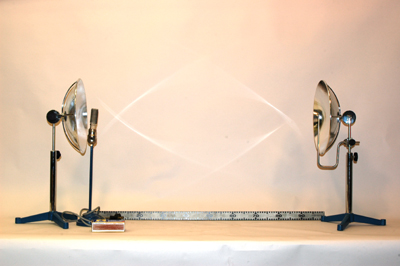
Description:
Radiative Heat Transfer, locally known as Light the Match.
Two large parabolic reflectors, 12 inches in diameter, one with a "white tipped" stick match at it's focus and the other with a nichrome heater element at it's focus. Each reflector has two adjusters on it, one adjusts for height and the other for tilt angle. Both adjusters will be important when it come to aligning the foci of both reflectors.
Equipment |
Location |
ID Number |
|
|
|
Two Parabolic reflectors With Heater |
4B40.10 |
|
Spare Heaters |
|
|
Match |
|
Setup:
Alignment of the two parabolic reflectors: Alignment can be tricky and time consuming the further apart you place the two reflectors. 3 meters seems to be the maximum separation with this system.
- The set up process might take time, so it would be a good idea to set up the demo beforehand.
- Place the parabolic reflector with the heater at one end of the table.
- Move the heater in and out of the focus to find the foci. The best way to do this is to put your face in the line of sight of the reflector. When the whole reflector has a red-orange glow and you can feel the heat on your face, you're good to go. The heater is close to the focus point of the reflector. Make sure that the whole reflector has this red-orange glow to it all the way the the receiving reflector. One may have to adjust the reflector’s tilt angle or height to maximize the reflectivity of the heat.
- Across the table move the receiving reflector in the line of sight of the transmitted radiation. Again one may have to adjust the reflector’s tilt angle or height to maximize the heat being received.
- To find the focus of the match tip to go into. One can use a peace of paper or there finger tip to feel and see the re-focused heat spot. Caution! When using your finger to find the best location for the match, this hot spot is “HOT” and can be painful and burn.
- Once the spot has been found, wiggle the match tip into place. One may have to adjust the match’s height and/or distances from the reflector to reach the maximize amount reflectivity of the heat to ignite the match.
Cautions, Warnings, or Safety Concerns:
- Try to align really carefully because if they are not aligned appropriately, the match will take time to light.
- Beware of the heater.
- When using your finger to find the best location for the match, this hot spot is “HOT” and can be painful and even burn.
Demonstration:
This demonstration shows radiative heat transfer, heat energy or infrared radiation, which can be focused and then transmitted much the same way as light and sound waves can. After setup, you just need to plug the heater into an outlet and wait. Now you can try placing the piece of paper or metal in to the path of the radiation so that the students can see how the light is being reflected off of the first mirror. It helps them to see that infrared waved, or heat, acts just like visible light, even though they cannot see it. Another thing to show students in this demo is that although they may not be able see the infrared radiation, they can certainly feel it. Ask for a volunteer to hold up their hand in the direct path of the light reflecting off the first mirror. Don't worry, the students won't burn themselves, but they will be able to feel the increase in temperature caused by the light waves. After you put the match on the focal point of the receiving reflector, and then just wait. The wait time depends on how close the reflectors are to each other. The further apart the reflectors the longer the time will be. The match will flare up and catch on fire due to the radiative heat being transmitted from one focus to the another focus and the infrared heat builds up to the ignition point of the match. You can repeat this several times for effect. Usually any kind of flame or explosion will immediately captivate your audience.
|
|
|
|
|
|
References:
